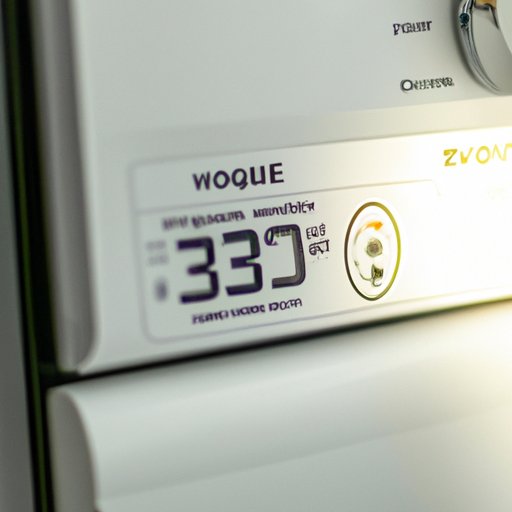Introduction
Maintaining the proper temperature in your refrigerator is essential for keeping your food fresh and safe. If the temperature is too high, food can spoil quickly. On the other hand, if it is too low, food can become frozen and lose its flavor. It’s important to understand the role of temperature in refrigerator storage and how to measure and adjust the temperature of your refrigerator to ensure optimal food safety and quality.

Exploring the Role of Temperature in Refrigerator Storage
Temperature plays an important role in the storage of food in a refrigerator. When food is stored at temperatures that are too warm, bacteria can grow more quickly, leading to food spoilage. On the other hand, freezing temperatures can cause foods to lose their flavor, texture, and nutritional value. It is important to keep the temperature of your refrigerator within the recommended range to ensure that food remains safe and flavorful.
When adjusting the temperature of a refrigerator, there are several factors to consider. The type of food being stored, the amount of food being stored, the frequency of opening and closing the door, and the ambient temperature of the room all play a role in determining the ideal temperature setting for a refrigerator.
How to Measure and Adjust the Temperature of Your Refrigerator
There are several methods for measuring the temperature of a refrigerator. Many modern refrigerators come with a built-in thermometer, which makes it easy to check the temperature at any time. You can also purchase an external thermometer to place inside the refrigerator. This will allow you to take multiple readings throughout the day to ensure that the temperature remains consistent.
Once you have determined the temperature of your refrigerator, you can make adjustments as needed. Most refrigerators have a thermostat control knob located on the interior wall. By turning this knob, you can raise or lower the temperature of the refrigerator. Make sure to make small adjustments and wait a few hours before making further changes to allow the temperature to stabilize.
The Ideal Temperature for Keeping Foods Fresh in a Refrigerator
The ideal temperature for storing food in a refrigerator depends on the type of food being stored and other factors. Generally, perishable foods should be stored at a temperature of 40°F (4°C) or below. This temperature range will keep bacteria from growing and prevent food spoilage. Certain types of food may require a higher or lower temperature for optimal storage. For example, certain fruits and vegetables may need to be stored at warmer temperatures to prevent them from becoming overly ripe.

An Overview of Refrigerator Temperature Regulations
In many parts of the world, there are local regulations governing the temperature of a refrigerator. These regulations are designed to ensure that food remains safe and of high quality. In addition, there are health standards related to refrigerator temperature that must be adhered to. Depending on where you live, these standards may vary, so it’s important to familiarize yourself with the regulations in your area.

Evaluating the Benefits of Different Refrigerator Temperatures
Different temperatures can offer advantages and drawbacks when it comes to food storage. Lower temperatures can help prevent bacteria from growing and food from spoiling. However, lower temperatures can also cause some foods to freeze, resulting in a loss of flavor and texture. On the other hand, higher temperatures can help keep some foods from becoming overly ripe, but can also lead to an increase in bacteria growth.
A Comparison of Refrigerator Temperature Settings Around the World
The ideal temperature for storing food in a refrigerator can vary depending on the region. In hot climates, the temperature may need to be set higher to prevent food from spoiling quickly. In cold climates, the temperature may need to be set lower to prevent food from freezing. It is important to familiarize yourself with the typical refrigerator temperature settings in your region to ensure that your food remains safe and of high quality.
Conclusion
Maintaining the proper temperature in a refrigerator is essential for keeping food fresh and safe. It is important to understand the role of temperature in refrigerator storage and how to measure and adjust the temperature of your refrigerator. The ideal temperature for storing food in a refrigerator depends on the type of food being stored and other factors. Local regulations and health standards may also affect the temperature of a refrigerator. Finally, the ideal temperature for storing food in a refrigerator can vary depending on the region.
By understanding the importance of temperature in refrigerator storage and following the recommendations outlined in this article, you can ensure that your food remains safe and of high quality.


